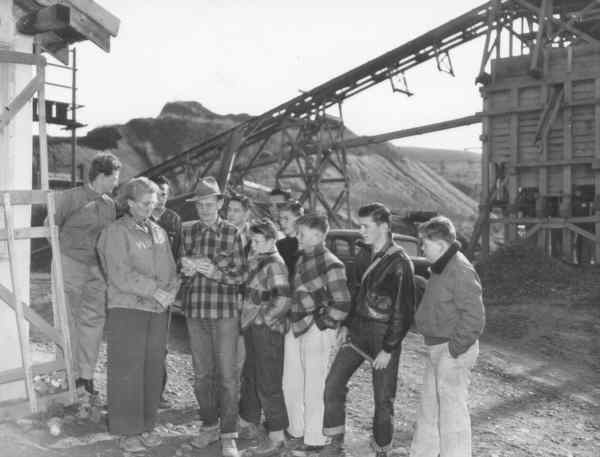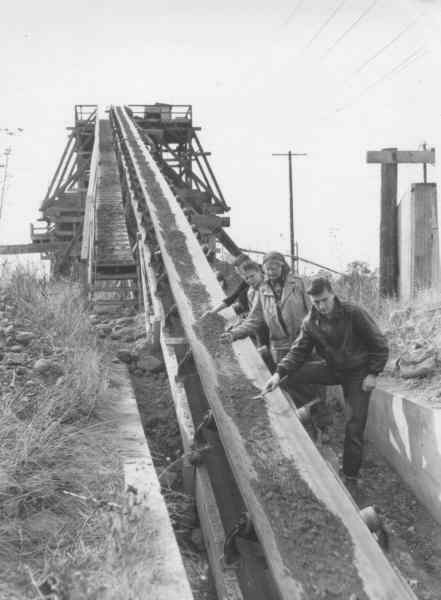Irvington Fossils - Background Information
by Phil E. Gordon
adapted from Tri-City Voice, December 7, 2004
Events a century and a quarter ago, 137 years to be exact, began putting Irvington on the Universal Map. In about 1867, Lorenzo Gordin Yates, a Centerville Dentist with a burning interest in natural history, found fossil bones in Mission Creek in Irvington, California. Curious about the kind of animals they were from, and since no authorities were yet in California, he sent them to the Peabody Museum at Yale, New Haven, Connecticut. He was informed that there had been horses, camels and elephants living in the area, possibly a million years ago.
 |
 |
| 1948, Left to right: Mrs Helen Silver, Mrs. Stanley Bell, Robert Broy, Wesley Gordon Sr., Hermon Ooswald, Billy Gordon, Lester Kent Jr., Bryon Lowis, Wesley Gordon Jr., Leonard Hennigon, Philip Gordon. Gordon Sr. holding prepared half jaw of camel of Pleistocene Epoch | 1948 Watching for fossils (left to right) Byron Lewis, Billy Gordon, Stanley Bell, Leonard Hennigan |
In 1936 a young Paleontologist, Ruben A. Stirton, eventually to succeed Charles L. Camp as Head of the Department of Paleontology, U.C. Berkeley, visited the Yates site; he also found fossils - one of them, a species new to science. In 1939, he published "Cenozoic Vertebrates of the San Francisco Bay Region" in which he named this new animal, Tetrameryx irvingtonensis Stirton; a four-pronged antilocaprid, ancestral to the Pronghorn Antelope now found across the sagebrush plains and mountains of the West. Stirton determined it hadn't been found in other fossil assemblages and named this new faunal age Irvingtonian of the early Pleistocene Epoch.
Wesley Dexter Gordon moved to the Bay Area from Michigan and loved to collect rocks. In about 1943, Wesley, called "Deck" by his family and "Wes" by his California friends, took a group of school aged boys, including his three sons, on another rock collecting trip. This time it was to a spot known to have fossils - a gravel pit in Irvington. He entered with permission of the owner, Mr. Freitas who later lost his life when he fell into one of his own gravel hoppers. That day they found the complete lower jaw with the diagnostic teeth of Camelops, a mammal, ancestral to the modern camel. This had to be the spot that Yates found petrified bones so long ago.
Thus began the next phase of the fossil dig that continued until approximately 1959. During the intervening years of weekend and some mid-week visits, twelve to sixteen boys and their director, Wes Gordon, retrieved over 150,000 specimens. They named themselves The Boy Paleontologists of Hayward. Their motto was, "What we find belongs to the public domain of science." These finds were to be donated to the University of California, Department of Paleontology. The group celebrated their 365th trip with Anna and Stanley Bell who had purchased the quarry and retired from it when Hwy 680 was constructed. Notoriety came their way when Life Magazine personnel arrived in Irvington to photograph and interview the boys who dug fossils and published their story Dec.10, 1945.
In the meantime, a young Paleontology student, Donald E. Savage decided his PhD thesis would describe this large fossil collection. In this 100 page document, published in 1951 as "Late Cenozoic Vertebrates of the San Francisco Bay Area," Don Savage had so many fossil horse jaws and teeth, Equus caballus, that he was able to show more difference between teeth in one jaw than the differences between whole Families of other prehistoric horses. He reduced 27 families of horses down to 7 - quite a contribution to worldwide understanding of the development of horses.
In 1957 Wes Gordon traveled to Sacramento and persuaded the California State Highway Department to shift the planned highway to bypass the primary fossil "T2" location where the Giant Short-faced Bear (Arctodus simas) had been found in Irvington's hills. An $18,000 grant from the California State Parks Division allowed intensive digging for two summers when 4 additional animal species were added to the already substantial list of 54 kinds of vertebrates and invertebrates. From this last excavation, Jean Durham earned her Masters Degree on the additional finds from her professor, Don Savage at U.C. Berkeley.
There are three unique, new to science, species from the Irvingtonian Faunal group to date: Irvington Mouse (Peromyscus irvingtonensis Savage); Irvington Coyote (Canis irvingtonensis Savage); Irvington Four-pronged Antelope (Tetramaryx irvingtonensis Stirton). (See the other major species in the list below).
It is interesting that one of the key characteristics of this Faunal Age is missing; a huge bison, Bison latifrons. Its fossil remains are not found in the Irvingtonian, about 1.8 million (most recent determination by Potassium-Argon dating technique) to 780,000 years ago but it shows up in the famous Rancho LaBrea Fauna of Los Angeles, aged at from about 500,000 to 10,000 years ago. Mammoth fossils are among the most conspicuous bones found (pictured is a skull and Don Savage preparing the biggest find yet, a 13.5 ft. mammoth tusk, being removed and taken to the preparation lab at U.C. Berkeley).
When the main fossil site was purchased by the State for Hwy 680, and the last two years of excavation were over, Wes Gordon, then a Curriculum Supervisor for San Lorenzo Schools, set up a museum at Martin School. The museum included Irvingtonian fossils and other Natural History specimens: stuffed birds and mammals, shells, crabs, rocks, minerals, etc. This eventually became the Wesley Gordon Natural History Museum of Discovery (later moved to Bohannon School, San Lorenzo).
Collection fossils include:
Canada Goose (Branta canadensis Linnaeus)Turkey
Ground Sloth (A.) (Megalonyx sp. Harlan)
Ground Sloth (B.) (Paramylodon harlani Owen)
Benson's Ground Squirrel (Citellus bensoni Gridley)
Pocket Mouse (Perognathus sp. Maximilian)
Vole (Meadow Mouse) (Microtus sp. Shrank)
Wood Rat (Neotoma sp. Say and Ord)
Cottontail Rabbit (Sylvilagus sp. Gray)
Dire Wolf (Canis cf. dirus Leidy)
Fox
Giant Short-faced Cave Bear
(Arctodus simas [yukonensis?] Cope )
California Sabrecat (A) (Smilodon californicus Bovard)
Sabrecat (B) (Dinobastus sirus Cope)
(Marsupial) Lion
Badger (Taxidea sp.)
Seal (Phoca sp.)
Mastodon (Mammut sp.)
Columbian Mammuth (Mammuthus columbi Falconer)
Single-toed Horse (Equus caballus Linnaeus)
Peccary (Tayassuidae, Genus? sp.)
Camel (A) (Camelops minidokae Hay)
Camel (B) (Tanupolama sp. Stock)
Deer (Odocoileus sp. Rafinesque)
Musk-ox-like Bovid (Eucatherium sp. Sinclair & Furlong)
